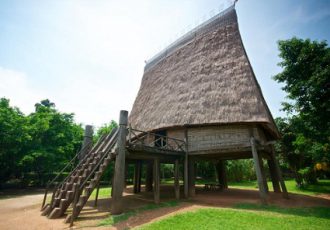Hanoi Fine Arts Museum
If you are interested in the fine arts of Vietnam, the Hanoi Fine Arts Museum located just behind the Hanoi Temple of Literature is certainly an address you should visit. So far, it is unfortunate that this museum often gets overlooked by tourists and is not very often recommended by travel agencies either.
First of all, it is a very beautiful museum whose collections are exhibited in a former building of a Catholic college for girls built during the French Indochina period. This three-storey building, whose style has been adapted somewhat to the tropical landscape, is preceded by a large courtyard in the middle of which stands a Cham art sculpture, known as a “linga”-one of the familiar symbols of the Cham civilisation.
What to see in this museum?
The value of the Hanoi Fine Arts Museum consists in the fact that it encompasses very vast, very complete collections of the main fields of fine arts in Vietnam, namely sculpture – a Vietnamese asset, painting with very varied genres (on oneself, in oil, on lacquer…), the folkloric arts, the applied arts, the whole is classified in a chronological way, by dividing the history of fine arts into major periods, namely the prehistory, the feudal era, and the modern era. ), the folkloric arts, the applied arts, and the whole is classified in a chronological way, by dividing the history of the fine arts into major periods, namely prehistory, the feudal era, the first half of the twentieth century, the very recent period of the “doi moi” revival, as well as the contemporary arts. This detail is very remarkable: the museum is sometimes animated by a thematic exhibition, often on contemporary themes and contemporary authors as well, a way to show the modern face of the country and the evolutions of today’s fine arts in the country.
It is natural that most tourists have a special interest in the traditional and folk arts of Vietnam. The Hanoi Museum of Fine Arts devotes a large space to presenting the arts of the primitive era; Vietnamese arts from the 11th century to the 15th-century corresponding to the reign of the most powerful dynasties, but also to the apogee of Vietnamese arts; arts from the 15th to the 18th century (also having a very own style)…so many periods of which the traces are still visible in pagodas, temples, citadels… scattered all over the country.
Oil, silk and lacquer paintings are all represented, even creations of artists involved in the patriotic work during the country’s two patriotic wars, so it is a very complete and rich panoramic picture. This figure tells you something: 3,000 exhibits from the total of 20,000 objects that the Museum houses.
Here is some useful information for your visit: tickets cost 30,000 đồngs per person or about one euro. Students get a discounted rate of 15,000 đồngs, under 16s get a discounted rate of 10,000 đồngs, and children under 6 are free. Although this is the case for the majority of cultural institutions and historical monuments in the country, there is no discounted rate for Vietnamese nationals. If you want to take a guided tour, ask at the front desk, it will cost you 150,000 đồngs. If you plan to take photos inside the museum, you will have to pay an additional (small) fee at the entrance.



